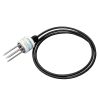Stevens HydraGO Portable Soil Moisture System
The Stevens HydraGO portable soil moisture system makes soil spot sampling quick and easy. Instantly measure soil moisture, electrical conductivity, and temperature.
Features
- Patented sensor instantly measures moisture, EC (salinity) and soil temperature
- Integrated Bluetooth for easy operation with free smartphone app
- Cost effective solution for portable on-the-go soil monitoring
- Free ground shipping
- Expedited repair and warranty service
- Lifetime technical support
- More
Overview
The Stevens HydraGO and HydraGO FLEX represent the most advanced portable soil sensor system. Simply insert the probe into the soil, and tap on the “Sample” button in the HydraGO app. The HydraGO and HydraGO FLEX communicate wirelessly with your smartphone or tablet using Bluetooth. The HydraGO and HydraGO FLEX system features a rugged, Delrin housing that contains a rechargeable battery. The internal battery will last for long field sessions with repeated and frequent data samplings.
Design
The HydraGO has a probe on the end of a shaft for easy surface measurements. It includes 4 segments so that the size can be adjusted from 25 to 84 cm (10 to 33 inches). The HydraGO FLEX has a detachable cabled probe that can be buried and left in the field. The cabled probe allows the user to collect data down a narrow-augured borehole. The HydraGO FLEX comes with a fanny pack and brush for easy on-the-go measurements.
Mechanics
Both HydraGO and HydraGO FLEX utilize the HydraProbe Soil Sensor technology for the soil measurements. The HydraProbe is an impedance-based sensor that fully characterizes the radio frequency energy distribution of a standing wave in the soil measuring both the real and “imaginary” dielectric permittivities. This provides excellent accuracy and precision of the soil measurements across a wide range of soil types.
In The News
Supplying Seattle’s Drinking Water: Using Data Buoys to Monitor the Cedar River Municipal Watershed
Providing clean, safe, and reliable drinking water for the 1.6 million people in the greater Seattle area is a top priority for Seattle Public Utilities (SPU). With limited water supplies, SPU dedicates considerable resources to maintain its watersheds and mountain reservoirs. About 70 percent of Seattle Water comes from the Cedar River Municipal Watershed , and the other 30 percent comes from the South Fork Tolt River Watershed . [caption id="attachment_39574" align="alignnone" width="940"] Data buoy in Chester Morse Lake . (Credit: Kevin Johnson / Seattle Public Utilities) [/caption] Jamie Thompson, a fisheries biologist at SPU, monitors aquatic ecosystems centered on fish listed under the U.S. Endangered Species Act (ESA).
Read MoreData-Driven Advocacy on the Lower Deschutes River
Like many freshwater environments, the Deschutes River in Oregon is under pressure from development, pollution, and climate change. Many rivers, streams and lakes in the Deschutes Basin do not meet Oregon water quality standards –where state water quality monitoring assesses levels of bacteria, pH, dissolved oxygen, temperature, and fine sediment. Hannah Camel is the Water Quality Coordinator for the Deschutes River Alliance (DRA), a non-profit organization that focuses on the health of the lower 100 miles of the Deschutes River–the area most affected by human intervention. As a data-driven organization, the DRA has benefited from the installation of two NexSens X2 data loggers.
Read MoreExpanding the Port Everglades: Real-Time Monitoring of Water Quality Conditions from Planned Dredging Operation
The Port Everglades in Broward County, Florida, serves large trade vessels and cruiseliners and incoming and outgoing recreational boaters. However, as cargo ships become larger, the port must expand. A dredging project led by the US Army Corps of Engineers will substantially deepen and widen the port's navigation channel to accommodate larger Panamax cargo ships and modern cruise liners. As a result of this project, a large amount of sediment will be displaced into the water column. This suspended sediment may settle outside of the project area, burying benthic organisms like corals, and possibly carrying harmful particulates to other regions. [caption id="attachment_39497" align="aligncenter" width="2560"] A CB-950 and CB-25 deployed on site at Port Everglades.
Read More








